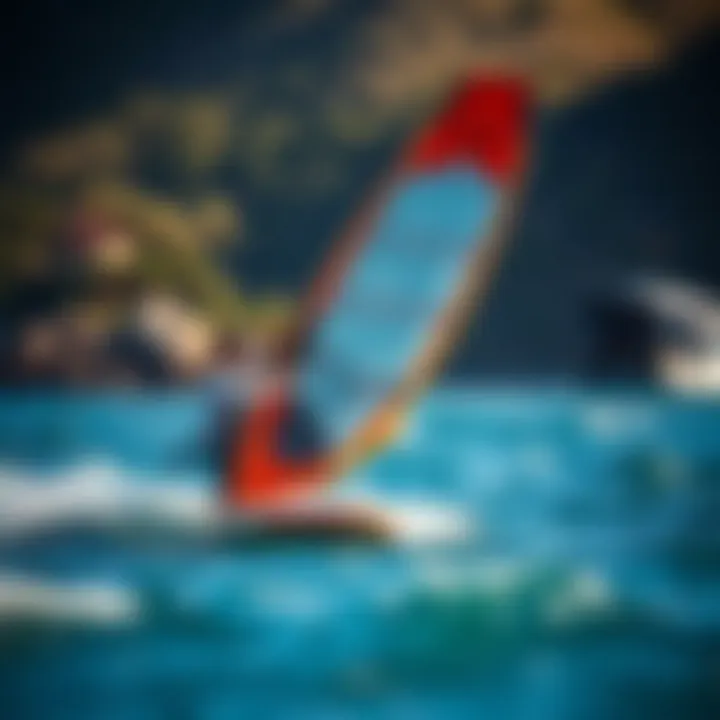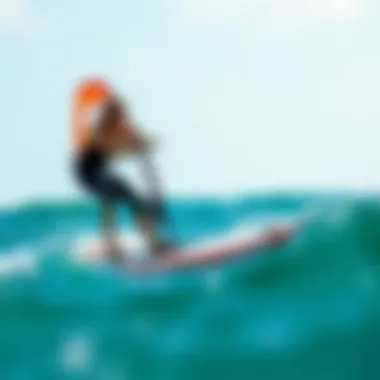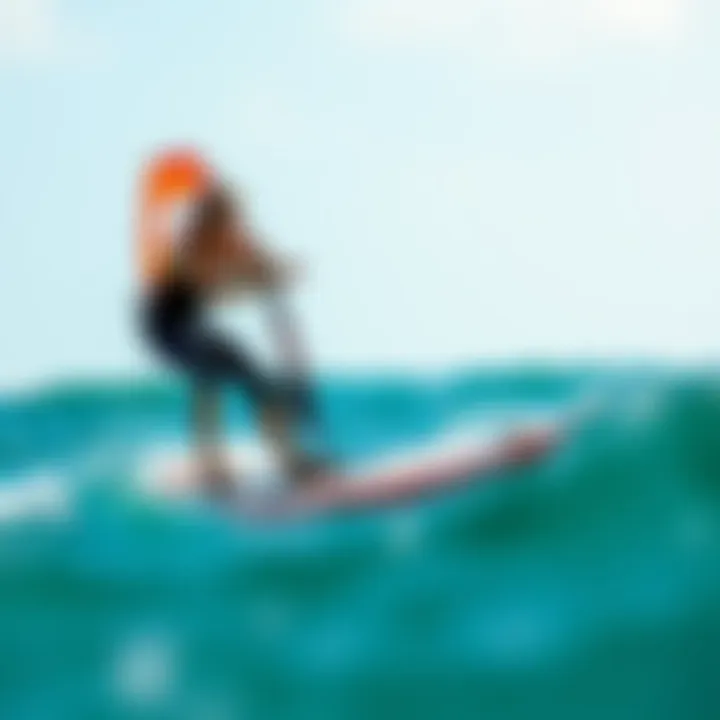Exploring Inflatable Windsurf SUP Boards: A Comprehensive Guide


Intro
In recent years, the watersport industry has witnessed a surge in popularity for inflatable windsurf stand-up paddle (SUP) boards. A perfect fusion of windsurfing and paddleboarding, these boards offer a unique experience on the water that appeals to enthusiasts of all levels. Whether you're gliding across calm lakes or riding ocean waves, understanding the design, functionality, and versatility of inflatable SUP boards can elevate your time spent on the water.
These inflatable boards are remarkably lightweight, making them easy to transport and store. Their compact nature allows adventure seekers to pack them up with minimal hassle, ushering in an era where spontaneity reigns supreme on the high seas. Yet, there's a lot to crunch when it comes to optimizing their performance and suitability for your particular needs. From material quality to performance metrics, this guide aims to unravel the intricacies that lie beneath the surface.
Before embarking on your journey through this comprehensive exploration, let’s delve into the essential techniques and skills that can make or break your experience with inflatable windsurf SUP boards.
Intro to Inflatable Windsurf SUP Boards
In recent years, the demand for inflatable windsurf stand-up paddle boards (SUP boards) has skyrocketed, attracting both novice enthusiasts and seasoned performers. These innovative boards represent the marriage of two exhilarating water sports—windsurfing and paddleboarding—creating a versatile experience on the water. The relevance of inflatable boards stems from their unique design and functionality, offering an alternative to traditional rigid boards that have dominated the market for decades.
The importance of this topic cannot be overstated, as understanding inflatable windsurf SUP boards enhances the overall experience in water sports. By diving into this comprehensive guide, we reveal the multiple advantages these boards possess, along with key considerations to keep in mind when integrating them into your water adventures.
Key benefits of inflatable windsurf SUP boards include:
- Portability: Inflatable boards can be rolled up and stored in a compact bag, making them easy to transport wherever you want to paddle or surf.
- Durability: Constructed with advanced materials, they can withstand various conditions and resist punctures, unlike their rigid counterparts.
- Stability: Many models provide excellent stability, which is particularly beneficial for beginners learning the ropes.
With enthusiasts across the globe embracing these boards, it’s essential to get a grip on what they are, how they have evolved, and the implications of their design elements.
The Evolution of Water Sports Equipment
Water sports have undergone a dramatic evolution, from the early days of paddleboards made from wood to the modern inflatable incarnations available today. Initially, paddleboarding was often perceived as a niche activity, enjoyed mostly in specific regions. However, as technology progressed, manufacturers began to craft boards that were not only functional but also accessible to a broader audience.
Close to water sports' heart is the innovation in materials and design techniques. Take drop-stitch technology, for instance, which allows for incredible rigidity once the board is inflated. Early iterations of buoyancy relied heavily on soft, flexible materials that didn’t provide the same performance edge. Today, however, boards are designed to offer a thrilling balance of flexibility and strength, facilitating various usage scenarios that cater to distinct skill levels.
Ultimately, the influx of inflatable designs has not just redefined windsurfing; it has opened the doors for new possibilities in location and leisure, allowing enthusiasts to embrace the waves without the logistical stress often associated with traditional, bulky boards.
Defining Inflatable Windsurf SUP Boards
Inflatable windsurf SUP boards blend elements of both stand-up paddleboards and windsurfing, combining the best features of each. Yet, while they share fundamental characteristics, these boards also have unique traits that set them apart. An inflatable windsurf SUP board typically comprises a soft and flexible outer shell filled with high-pressure air, providing buoyancy and stability.
What distinguishes these boards from rigid options is their ability to adapt to various environments and conditions. An inflatable SUP board offers:
- Versatility: They are great for flat water paddleboarding or catching some waves with a sail attached, delivering a hybrid experience.
- User-Friendly Design: Their lightweight construction makes them user-friendly for beginners while still offering enough performance for advanced riders to enjoy thrilling windsurfing sessions.
- Easy Storage: The ability to deflate and roll up for storage invites less hassle than traditional boards, which often require significant real estate.
In sum, inflatable windsurf SUP boards represent a significant leap in the evolution of water sports gear. They unravel many possibilities for keen water sports enthusiasts, making water activities more appealing and accessible than ever before. As we dive deeper into this comprehensive guide, we’ll explore the critical aspects of their design, performance, and care to ensure you maximize your fun in the sun.
Design and Construction
When diving into the world of inflatable windsurf stand-up paddle (SUP) boards, it’s imperative to pay attention to the design and construction. This aspect not only impacts the board’s performance but also its longevity and user experience. Proper construction means that enthusiasts can enjoy a seamless ride, whether they're cruising along calm waters or battling a windy day. Thus, understanding the various elements of design, such as material composition and dimensions, is crucial for selecting the right gear.
Material Composition
Drop-Stitch Technology
One standout feature of inflatable boards is drop-stitch technology. This innovative method consists of thousands of polyester threads connecting the top and bottom layers of the board. This makes the board incredibly rigid when inflated, rivaling that of rigid boards while keeping it lightweight and portable. The key characteristic here is its ability to maintain form without compromising the board's buoyancy. For windsurfing enthusiasts, this is beneficial as it enhances stability and facilitates better maneuverability on the water.
However, it’s worth noting that drop-stitch technology also comes with its share of maintenance requirements. While it's durable, the internal threads can wear out if not looked after properly—a small price to pay for such exceptional performance.
PVC vs. other materials
Next up is the debate between PVC and other materials. PVC, or polyvinyl chloride, is often favored for its toughness and resilience against abrasions, which is why many brands opt for it in their boards. Its prominent feature is its weather-resistant quality, making it suitable for various conditions like saltwater and UV exposure. When comparing PVC with alternatives like nylon or polyurethane, one quickly notices that PVC tends to provide a balance of price and durability, which is crucial for both beginners and seasoned surfers.
However, the drawback of PVC is its weight compared to other materials— boards can feel a bit bulkier, especially if you're carrying them around during a day of extensive use. Ultimately, selecting the right materials involves considering personal preferences and potential usage scenarios to ensure an optimal buying decision.
Dimensions and Weight
Length Variations
When it comes to length variations, these significantly influence the performance of an inflatable windsurf SUP board. Longer boards typically excel in straight-line speed, while shorter ones offer enhanced maneuverability. The choice of length is vital for those who have specific waters they frequent, as well as the skill level of the rider. A longer board can provide stability for beginners, which is often a deciding factor when selecting gear.
On the other hand, for those looking to race or surf within active wave conditions, shorter boards facilitate sharper turns. This offers enthusiasts the flexibility to adapt their board to their skill levels and environmental conditions, making length a key element in the overall design discussion.
Thickness Considerations


Thickness considerations often get overlooked, yet they hold significant importance. Thicker boards provide better buoyancy, which can be beneficial in rough waters. A thicker profile not only accommodates more weight but also results in increased stability on the water. For users planning extended outings, this represents a real advantage for comfort and safety.
Contrary to this, thinner boards might be preferable for advanced users looking to harness speed and agility. Such boards reduce drag in the water, but may sacrifice some stability. Capturing the right balance in thickness according to one’s needs can markedly enhance the windsurfing experience.
Ending
In sum, the design and construction of inflatable windsurf SUP boards hinge extensively on material choice, dimensions, and weight, all of which contribute to performance and user satisfaction. Understanding the nuances of drop-stitch technology, the benefits of PVC versus other materials, and the impact of varying lengths and thicknesses are essential for anyone delving into this water activity. With informed choices, enthusiasts can find a board that not only meets but exceeds their expectations.
Performance Aspects
When discussing inflatable windsurf stand-up paddle boards, performance aspects become crucial. They can make the difference between a stellar adventure on the water and a frustrating experience. Each element, from stability to speed, plays a role in how well these boards function in various conditions and for diverse skill levels.
Stability and Balance
Stability is one of the foremost concerns for anyone stepping onto a windsurf SUP board. A board that is wobbly or hard to balance can turn a day on the water into a nightmare, especially for beginners. Stability becomes vital, as it not only affects comfort but also safety. It can be influenced by several factors: the board's width, its overall shape, and how buoyant it is. Wider boards generally offer more stability, providing a better platform for users to stand on.
Particularly for newcomers, this stability allows them to gain confidence in their abilities, having something to rely on while learning the nuances of balancing in both calm waters and variable conditions.
In more advanced styles, stability still plays an important role, helping experienced paddlers execute tricky maneuvers with finesse. For instance, while performing a tack, an arched shape or a well-placed rail can help maintain balance during transitions.
In terms of practicing stability, here are a few insights:
- Choose the Right Size: A beginner may want to select a board with a larger width to improve stability during their sessions.
- Practice on Calm Waters: Before diving into choppy conditions, honing skills on a flat surface will build solid foundational balance.
- Engage Your Core: Keeping your center of gravity low and engaging the core muscles can enhance your balance.
"A stable board increases not just performance, but joy on the water."
Speed and Maneuverability
Following stability, speed and maneuverability become the next big players in performance. Speed in windsurfing can be exhilarating, whether you’re swiftly gliding across a lake or slicing through ocean swells. Understanding how speed can be achieved depends on several nuanced factors, such as the board’s design, the fins’ placement, and the choice of sail.
Inflatable boards tend to be a bit bulkier than their rigid counterparts; however, advancements in design have led to models that are surprisingly fast while still being inflatable. The adoption of streamlined shapes can significantly increase speed without sacrificing stability.
Maneuverability often connects directly to speed, as the ability to pivot and turn quickly can set apart a fantastic ride from a mediocre one. Some boards are tailored specifically for agility, featuring shorter lengths that allow for sharper turns and responses to rider commands. Here are key considerations when assessing speed and maneuverability:
- Board Shape: A pointed nose can cut through water more easily, contributing to higher speeds.
- Weight Distribution: Proper weight placement as you're riding can impact how effectively a board maneuvers.
- Sail and Fins: The configuration of your sail and fins can greatly affect how the board performs. Keeping the fins clean and in good shape ensures that the board tracks straight and responds well.
In summary, performance aspects of inflatable windsurf SUP boards do not just pertain to how well they float or how easy they are to transport. They encompass a collective understanding of how these boards can support user experiences through enhanced stability and thrilling capabilities, catering to both novices and seasoned riders alike.
Advantages of Inflatable Designs
When it comes to inflatable windsurf stand-up paddle boards, the advantages over their rigid counterparts can't be overlooked. In this section, we will explore how these boards offer unique benefits that cater to the modern paddler’s needs. From portability to cost-effectiveness, inflatable designs bring a fresh perspective that can enhance your experience on the water.
Portability and Storage
One of the standout features of inflatable boards is their portability. Imagine yourself heading to the beach without the hassle of strapping a giant hunk of fiberglass to the roof of your car. Inflatable boards, when deflated, can conveniently fit into a carry bag, which often resembles a large backpack. This means you can toss it in your trunk, storing it upright or flat without worrying about it taking up too much space.
The simplicity of transport allows for spur-of-the-moment trips to water bodies, making it easier for anyone, from busy professionals to weekend warriors, to indulge in their favorite sport. Whether you're hopping on a bus, cycling to your local lake, or embarking on a hiking trail that leads to a secluded beach, you won't break a sweat lugging your gear around.
- Easy to Pack: Simply roll up the board and place it back in its bag for storage.
- Lightweight: Many forgo the grueling workout of hauling heavy equipment.
- Accessibility: Ideal for those who live in smaller spaces or who may have limited vehicle options.
Affordability compared to Rigid Boards
Cost is often a deciding factor for many individuals looking to dive into water sports. Inflatable windsurf SUP boards generally offer a more affordable alternative compared to their hard-shelled cousins. While high-end models can be pricey regardless of the material, the manufacturing costs associated with inflatable technology tend to be lower.
For someone eager to get started without going into debt, this price point is appealing. As a result, inflatable boards can range from budget-friendly options that still deliver quality performance to mid-range selections that offer additional features without the high price tag.
Researchers have indicated that users who initially invest in inflatable options often end up using them more frequently since the initial financial barrier is less daunting. You can spend your money on gear that enriches your experience on the water rather than potential regrets on a more expensive, less practical model.
"When it comes to making a choice, many users will appreciate the cost-effective nature of inflatable boards without sacrificing quality."
Usage Scenarios
Understanding the various usage scenarios for inflatable windsurf SUP boards is critical in tailoring the equipment to meet specific needs of riders. Whether it’s a laid-back day on calm waters or gearing up for competitive racing, knowing the right board type can influence both performance and enjoyment. Evaluating these scenarios enables enthusiasts to make informed choices that enhance their experience on the water.
Recreational Use
For those looking to dip their toes in the waters of stand-up paddleboarding while also enjoying the thrill of windsurfing, inflatable boards cater beautifully to recreational use. The versatility of these boards allows for flexibility—they can be used for casual paddling on serene lakes or even navigating coastal waters with mild wind conditions. One of the most significant benefits is that they don’t break the bank, making it easy for newcomers to test the waters without a hefty investment.
Consider some key elements:


- Versatility: These boards can accommodate different activities like paddleboarding, windsurfing, and even light wave riding. This can be a tremendous way to maximize time on the water.
- Ease of Transport: Most inflatable boards can be rolled up and fit in a backpack or a car trunk. That means taking your water adventures on the road is less of a hassle.
- Stability: Many inflatable SUP boards are designed with wider bases, providing a stable platform for beginners who are just learning their balance.
When using the inflatable board for recreation, engaging in group outings can significantly enhance the enjoyment. Whether you're cruising with friends or enjoying a solo adventure, the atmosphere created while on the water is hard to match. Just keep an eye on the weather and consider packing light for the day with personal essentials.
Competitive Windsurfing
On the other end of the spectrum, competitive windsurfing presents a different set of challenges and requirements. While inflatable boards were once considered more suitable for leisurely activities, innovations have led to performance-oriented designs that can hold their own in competitive arenas. Understanding this space involves analyzing both the equipment and the skills required.
- High-performance Features: Competitive boards are often lighter and have enhancements in design that support speed and agility. Riders may find significant differences in fin setups, rocker profiles, and board shapes as manufacturers cater to the fast-paced demands of race courses.
- Specific Crafting for Conditions: Competitive boards often cater to a range of wind conditions. For example, certain boards perform better in lighter winds while others are optimized for high-wind scenarios.
- Skill Growth: Engaging in competitive environments can elevate a rider’s skills faster than casual outings. The adrenaline, pacing against others, and receiving immediate feedback push individuals to refine their techniques.
While the thrill of competition can be exhilarating, it’s essential to approach this path with a willingness to learn and adapt. Preparation is key—practice, invest in quality gear, and understand how to read wind patterns and water conditions.
"The best way to prepare for competitive waters is to be one with your board and the elements."
In summation, the usage scenarios for inflatable windsurf SUP boards range from fun and recreational outings to intense competitive experiences. Knowing what one’s goals are helps in selecting the appropriate board and makes for a much more fulfilling experience. Whether it’s soaking up the sun on a lazy afternoon or racing against the clock, these boards are tailored to facilitate various water adventures.
Maintenance and Care
Taking proper care of your inflatable windsurf SUP board is not just about keeping it looking good. It’s deeply tied to its performance, longevity, and, ultimately, your enjoyment on the water. Neglecting maintenance can quickly turn that prized paddle board into a weighty burden, dragging down your adventures and perhaps even posing safety risks. Regular maintenance extends the life of your board, preserves its abilities, and ensures that every outing is smooth sailing.
Cleaning Procedures
Cleaning your inflatable windsurf SUP board should be part of your routine, and it’s easier than pie—though it might seem a bit tedious at first. Here’s how you go about it:
- Rinse After Use: Always rinse your board with freshwater after being out on saltwater or muddy lakes. Salt can be particularly nasty, corroding material over time.
- Mild Soap Solution: If your board is covered in sand or grime, a mild soap solution can work wonders. Use a soft sponge or cloth to wipe it down, ensuring you don’t damage any graphics or material.
- Avoid High Pressure: When rinsing, don't direct high-pressure water from hoses at your board. It can lead to damage in seams or valves.
- Dry Thoroughly: After cleaning, it’s crucial to dry it completely before rolling it up for storage. This prevents mold or mildew from making a home in your board.
- Specific Stains: For tougher stains, consider a specific cleaner meant for inflatable products, but always ensure it’s safe for your material. Testing a small area can save you from future heartache.
By adopting a routine cleaning practice, you enhance your board’s durability and keep it in peak condition for those sunny days ahead.
Storage Guidelines
Where and how you store your inflatable windsurf SUP board can make or break its lifespan. Proper storage techniques should be a no-brainer if you want to hit those waves year after year. Here are some pivotal tips:
- Deflate for Storage: Before tucking away your board, ensure it is fully deflated. This not only saves space but also reduces stress on seams, preserving integrity.
- Cool, Dry Place: Ideally, store your board in a cool, dry area. Sunlight can fade colors and degrade materials over time.
- Avoid Sharp Edges: Be mindful of where you place your board. Any sharp edges nearby could puncture it during storage.
- Use a Board Bag: A storage bag designed for inflatable boards adds a layer of protection against dust and potential damage. Look for one with padding if possible.
- Temperature Check: Avoid extreme temperatures, whether hot or cold. These can compromise the materials. If it’s too chilly for you, it’s likely too chilly for your board as well.
Remember, investing time and attention in maintenance and care not only rewards you with better performance on the water but also prolongs the joy of your adventures. The care taken today translates into epic rides tomorrow.
By integrating these maintenance habits into your routine, you significantly elevate the experience of using your inflatable windsurf SUP board and uphold its value over time.
Safety Considerations
When it comes to inflatable windsurf stand-up paddle boards, safety is not just a luxury; it’s a necessity. Engaging in water sports can be exhilarating, but it also comes with its own set of risks. From unexpected weather changes to potential equipment failure, understanding safety considerations can make the difference between a fun day in the water and a dangerous situation. The following sections will address key safety elements that ensure a secure experience for everyone, from beginners to seasoned pros.
Essential Safety Gear
Having the right safety gear on hand is crucial for anyone venturing out on the water. This equipment not only enhances safety but also boosts confidence while paddling. Here’s a breakdown of the essential items:
- Personal Flotation Device (PFD): A well-fitting life jacket is a must-have. It ensures buoyancy in case of a fall or an emergency.
- Leash: A leash attaches you to your SUP board, preventing it from drifting away if you fall. This is particularly important in windy conditions.
- Waterproof Bag: Essential for holding valuables, documents, and snacks while out on the water. This keeps everything safe from splashes.
- First Aid Kit: You never know when a small injury might occur. A compact first aid kit that includes band-aids, antiseptic wipes, and other essentials is a wise choice.
- Sunglasses with UV Protection: Protecting your eyes should be a priority. Polarized sunglasses help reduce glare and improve visibility on the water.
- Appropriate Footwear: While some may prefer bare feet, water shoes can provide better grip and protect from sharp objects.
"Safety is no accident. It’s a choice that requires respect for the water and the activity."
Awareness of Weather Conditions
The ability to read and respond to changing weather conditions is a pivotal aspect of water safety. The wind, waves, and temperature can shift dramatically, often catching people off guard. Here’s how to stay aware:
- Check the Forecast: Before heading out, always check local weather reports. Apps and websites dedicated to water conditions can provide real-time data.
- Look for Signs: Clouds, changes in wind direction, and even drops in temperature can signal worsening conditions. Stay vigilant and be prepared to head back if needed.
- Know Your Limits: Understand your own skill level and physical condition. If conditions appear beyond your ability to handle safely, it’s better to err on the side of caution.
- Wind Speed Awareness: Windsurfing typically requires wind, but excessive wind can lead to dangerous scenarios, especially for beginners. A good rule of thumb is to avoid venturing out in winds exceeding 15 knots without proper experience.
- Tides and Currents: Be aware of local tides and currents as they can significantly affect your paddling experience. Understanding these factors can help in planning your routes.
In summary, safety considerations while using inflatable windsurf SUP boards should always be prioritized. The right gear, combined with a keen awareness of weather conditions, allows enthusiasts to enjoy their time on the water while minimizing risks.
Choosing the Right Board
Selecting the correct inflatable windsurf SUP board matters a great deal, especially if one aims to get the most out of their time on the water. Each board comes with its own unique set of features and specifications that can make or break an overall experience. The pivotal role of this selection process cannot be overemphasized. Not only does the right board enhance performance, but it also aligns with your individual style and skill level, making it essential to have a keen understanding of personal needs.
Identifying Personal Needs and Preferences
When navigating the ocean of options available in the world of inflatable windsurf SUP boards, self-reflection is indispensable. Start by pondering some key questions:


- What is your skill level? Beginners may favor stability over speed, while seasoned surfers may seek maneuverability.
- What type of water conditions do you usually face? Flatwater boards differ from those suited for choppy waters.
- How often do you plan to use it? If the activity is more of a sporadic hobby, a more affordable option may highlight your choice.
Every individual has a different relationship with water sports, making it necessary to choose a board that fits both your practical needs and preferences. Think about features like board length, width, and volume. For beginners, a wider board typically offers more stability, whereas narrower boards can offer increased speed for those with some experience under their belts. Incorporating various opinions and personal anecdotes can be enlightening as you explore your options.
Comparative Analysis of Popular Brands
With extensive choices available, understanding the differences between leading brands could clarify your options. For instance, brands like Red Paddle Co and BIC Sport have carved out significant reputations for durability and design.
- Red Paddle Co: Renowned for their quality and technology, many users appreciate their advanced drop-stitch construction, contributing to enhanced firmness and performance. Users often mention their paddle boards' ability to hold air well even after prolonged use.
- BIC Sport: Offering options that are often regarded for their price point, many entry-level surfers find BIC Sport boards both affordable and functional. However, while they may lack in advanced features, they bridge the gap for enthusiasts looking to dip their toes into windsurf SUP without breaking the bank.
"Choosing the right inflatable windsurf SUP board is like choosing your partner in crime; it should complement your adventures, not hold you back."
In addition to Red Paddle and BIC, looking at user reviews on platforms like Reddit or Facebook can reveal much about brand performance and customer service experiences. People’s testimonials can highlight which features they loved, or what issues they faced. Therefore, having a comparative analysis not only strengthens your decision-making process but also narrows down options to those that might be the best fit for you.
Expert Insights and Reviews
Gathering expert insights and consumer reviews is a crucial part of understanding inflatable windsurf stand-up paddle boards. The knowledge of seasoned professionals and feedback from users not only enhances comprehension but also highlights practical aspects that could make or break the experience on the water. Informed opinions help potential buyers make sound decisions, weighing the pros and cons from various perspectives so that they can align their choices with personal preferences and needs.
Interviews with Professional Wind Surfers
Engaging with professional wind surfers brings rich, firsthand knowledge to the forefront. These individuals have ridden a variety of boards, spanning numerous brands and models. Their insights often illuminate features that beginners might overlook—like board responsiveness or stability under changing wind conditions.
For instance, a seasoned windsurfer might reveal that certain inflatable boards handle gusts better than others, perhaps due to their design or material. Additionally, professionals often discuss tips and tricks that help maximize performance. From corrective techniques to maintenance advice, their expertise is invaluable for both novices and seasoned riders refining their skills.
In a recent conversation with a competitor who has participated in several championships, he emphasized the importance of board choice in competitive scenarios. "You really have to feel connected to your board; it's like an extension of yourself out there on the water," he stated, indicating that finding the right fit can impact performance critically.
Consumer Reviews and Feedback
While expert opinions hold significant weight, the voices of everyday users echo loudly in the decision-making matrix. Consumer reviews often provide a more relatable take on the practicality and durability of inflatable boards. They shed light on aspects such as ease of transport, packing size, and how well the board actually performs during recreational outings.
Many users rave about the convenience of inflatable models. A post from a Reddit discussion highlighted that an enthusiastic paddler reported, "I can fit my board in the trunk of my car!" This convenience is a game-changer for those with limited storage space or who travel frequently.
Feedback also often includes remarks on customer service from manufacturers, which can be particularly enlightening. A positive experience with a company's support team can lead to greater loyalty and satisfaction with a product. For instance, users recount situations where they needed assistance after an equipment malfunction and received prompt, helpful responses.
Overall, when buyers consult reviews and insights from both experts and users, they equip themselves with a well-rounded understanding of their options, which increases the likelihood of making a choice they will be pleased with long term. For those intrigued, platforms like Reddit or consumer review sites are treasure troves of information on these boards.
Future Trends in Windsurf SUP Technology
As we look toward the horizon of water sports innovation, the future of inflatable windsurf stand-up paddle boards holds tremendous promise. These advancements not only enhance the experience for enthusiasts but also embed sustainability into the core of water sports. Understanding these trends is essential for anyone involved in windsurfing or paddleboarding, whether you’re an instructor, marketer, or simply an adventure seeker.
Innovations in Inflatable Technology
Technology in the realm of inflatable boards is evolving at a rapid pace. Manufacturers are focusing on developing materials that not only make boards lighter but also stronger and more durable. One notable innovation is the incorporation of advanced drop-stitch construction, which utilizes thousands of polyester threads to connect the top and bottom layers of the board. This results in a board that feels solid on the water while still being easy to transport.
Key Innovations Include:
- Enhanced Inflation Systems: New pump designs are streamlining the inflation process, making it quicker than ever to get on the water.
- Smart Technology Integration: Some boards are now being designed with built-in sensors that can provide real-time data such as speed, stability, and even wind conditions.
- Temperature Resistant Materials: As conditions vary, these new materials help maintain the integrity of the board, preventing breaches or deformation in extreme weather.
Implementing these innovations not only improves performance but appeals to a broader audience that looks for efficient solutions to their windsurfing needs.
Sustainability in Materials and Production
With growing concerns about environmental impact, sustainability has taken center stage in the production of inflatable windsurf SUP boards. Manufacturers are now seeking eco-friendly materials that do not compromise performance. For instance, some companies are using recycled PVC or plant-based composites for their boards, significantly reducing the carbon footprint associated with production.
"Sustainability isn’t just a trend; it’s a pivotal shift in how we approach water sports equipment manufacturing. As we embrace eco-friendly practices, we can also protect the beautiful environments we love to explore."
Sustainable Practices in Manufacturing Include:
- Water-based Adhesives: Reducing harmful chemicals traditionally used in binding materials.
- Local Sourcing of Materials: Less transportation means lower emissions and support for local economies.
- Durability Focus: By creating products that last longer, the need for frequent replacements—and the waste that comes with them—can be minimized.
These measures not only contribute to preserving the environment but also resonate with a growing demographic of consumers who prioritize sustainability in their choices. As the awareness of eco-friendly products rises, companies that embrace these changes stand to gain a competitive edge in the rapidly evolving market of inflatable windsurf SUP boards.
Culmination
In the expansive world of water sports, inflatable windsurf SUP boards represent a unique intersection of versatility and practicality. These boards are not just a passing fad; their development speaks volumes about innovation in the sporting goods industry. As we've explored throughout this article, there are significant elements to consider when embracing these inflatable designs. From their construction to how they stack up against rigid alternatives, each aspect offers distinct benefits for diverse user preferences.
Recap of Key Points
- Design and Construction: The materials used in these boards, such as high-quality drop-stitch technology, play a pivotal role in their durability and performance. Understanding this can help users select a board tailored for their specific needs.
- Performance Aspects: Stability and balance are crucial while windsurfing, and inflatable boards are designed to meet these demands effectively. Moreover, their capability to maneuver smoothly through various water conditions enhances the enjoyment for paddlers.
- Advantages of Inflatable Designs: Portability is one of the standout features. Users can easily inflate and deflate, allowing effortless transportation and storage. The cost-effectiveness compared to traditional rigid boards further adds to their appeal, especially for budget-conscious adventurers.
- Usage Scenarios: Whether one is into casual paddling or competitive windsurfing, inflation boards provide adaptability to meet various sporting desires.
- Maintenance and Care: A focus on cleaning and storage can prolong the lifespan of these boards, thereby protecting the investment made by enthusiasts.
- Safety Considerations: Safety gear and awareness of weather conditions cannot be overlooked, as these practices ensure a safe and enjoyable outing on the water.
- Choosing the Right Board: By understanding personal needs and comparing popular brands, users can make informed choices that enhance their windsurfing experience.
- Future Trends: Innovations in sustainable materials reflect the industry's trajectory towards eco-friendliness while integrating advanced technology.
Final Thoughts on Inflatable Windsurf SUP Boards
As the industry continues to innovate and adapt, staying informed about these trends will only enrich one's adventures. New technologies will emerge, but the need for connection with the environment and fun will always remain at the forefront. Embracing inflatable designs could very well be the key to unlocking exciting outdoor adventures.







